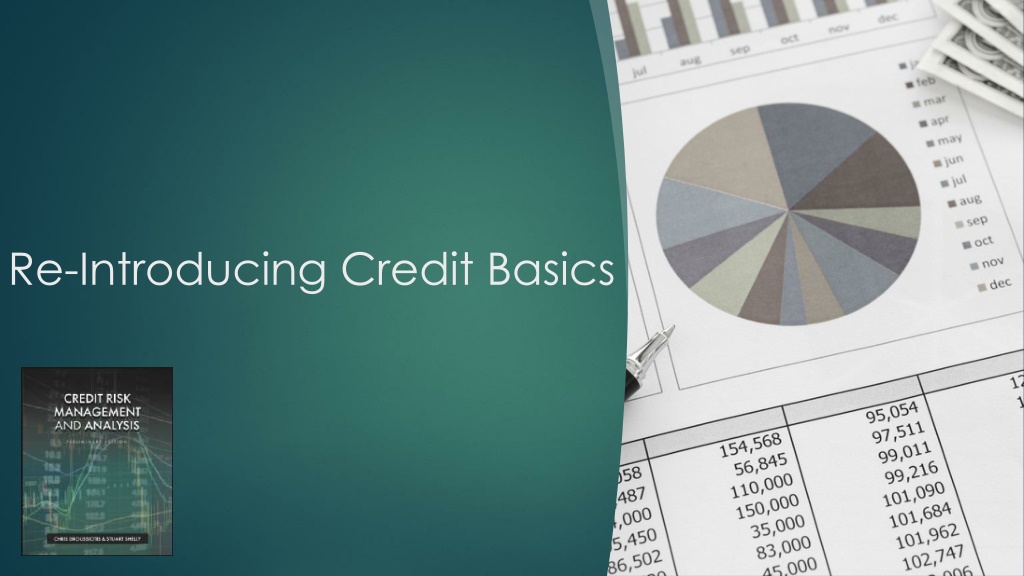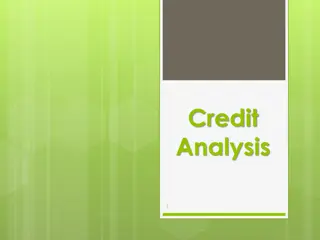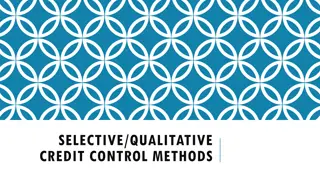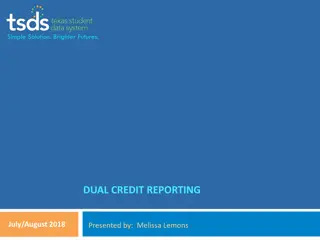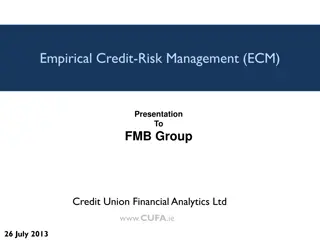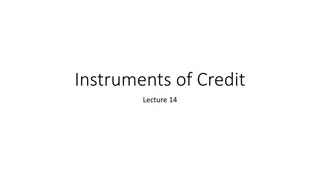Re-Introducing Credit Basics
In Corporate Finance, understanding credit basics is crucial. Explore the risks that affect the value line, from economic factors to specific strategies for management and lenders. Learn about CAMELS bank ratings and the regulatory landscape, essential for financial stability and risk management in banking. Gain insights into managing risks, determining expected returns, and maintaining the value line in a dynamic financial environment.
Download Presentation

Please find below an Image/Link to download the presentation.
The content on the website is provided AS IS for your information and personal use only. It may not be sold, licensed, or shared on other websites without obtaining consent from the author. Download presentation by click this link. If you encounter any issues during the download, it is possible that the publisher has removed the file from their server.
E N D
Presentation Transcript
Credit Basics What s This?
Risks that are pushing the Value Line down FIELDS OF FINACE Corporate Finance / Investment Credit Risk Management Analysis EXIT Risk (Volatility) Expected Value Line Growth (Return) Finance Strategies to Keep the Value Line Up Initial Investment ENTRY 3 FACTORS BEFORE YOU INVEST Measure Expected Return Quantify Risk Set Time (Exit)
From the Prospective of Mgmt/Equity Corporate Finance Risks that are pushing the Value Line Down: Economy Competition Government Disasters Other Systemic/Firm Specific Risks Strategies to Keep the Value Line Up Operating Strategies Transactional Strategies Financing Strategies Social Responsibility
From the Prospective of Lenders Credit Analysis Risks that is pushing the Value Line Down: Economy Government Other Systemic/Firm and Asset Class Specific Risks Strategies to Keep the Value Line Up Loan / Bond Structure Debt Capacity Analysis Sound Credit Analysis CAMEL Approach
Corporate Banking: CAMELS Bank Ratings The OCC regulates banks and performs regular reviews of banks, with the largest banks under constant regulatory review, due mainly to their massive size and risk in the event of a negative outcome. Bank regulators have developed a rating scale from 1 to 5, where 1 is the highest and 5 being the lowest, wherein the regulators measure banks against various operational, qualitative, and quantitative attributes. The rating systems is an acronym called CAMELS, which stands for: Capital Adequacy. Asset Quality. Management Earnings and Cash Flow Liquidity interest rate sensitivity and ability to convert assets to cash. Sensitivity to certain risk exposures Any bank with a rating below 2 is considered troubled
Corporate Banking Quantitative Approach Bank Asset Rating Categories All commercial banks, credit agencies, and institutions that lend money to corporations, focus on the following five areas of analysis when rating the Borrower and the loan based on the probability of default. Loan-to-value (LTV) or debt capitalization ratio: This ratio, expressed as a percentage, compares the enterprise debt to its total capital, or total value of the asset or business. It is important to look at each tier of credit in the capital structure to examine priorities and collateral interests. Leverage ratio of debt to EBITDA or EBIT: This leverage ratio, or debt to cash flow ratio, is one of the most popular ratios to used analyze the solvency and credit quality of a company. Coverage ratios describing the Borrower s ability to service either Interest alone or the combination of Interest and Principal, include EBITDA / interest and cash flow (EBITDA) to debt service (Principal and Interest): Cash flow forecasts, typically using a 30% haircut to base projections: Customized operating ratios based on the company s business that which can be cyclical or seasonal or depend on commodity pricing
Bank Asset Rating Categories Based on how each borrower and loan is assessed against the ratios and measures, most banks use a rating scale for their internal portfolio risk management. An example of which is below:
Corporate Banking Qualitative Approach Credit risk analysis involves the analysis of an obligor to determine their credit worthinesscreditworthiness regarding their ability to repay and service (payment of periodic interest payments) a debt. The foremost consideration for repayment of a debt, is the obligor's Willingness and Preparedness to repay the debt do they have any intention of repaying the debt, and do they have the capacity to do so? 5 C s of Credit: Character see discussion of the Client Acceptance Memorandum (CAM) 1. Collateral as a second source of repayment in the event of default and the needs of the lender to satisfy the obligation through liquidation of collateral. 2. Capital adequacy of amount of funding for a business to execute its plan and sufficient investment at risk on the part of the enterprise and principals representing the borrower. 3. Capacity as determined by the collateral and debt service capability as forecast in projections and based on historical proven experience of the borrower. The Capacity C incorporates the notion of Cash, Cash Flow and Coverage Ratios (debt Service and leverage, as discussed in Chapter 1.) 4. Conditions the structure of the loan and the documentation stipulations 5. Credit Risk/Default and Loss in Event of Default The purpose of Credit Analysis is to mitigate Credit Risk
Client Qualification & Credit Process Review of Templates Client Acceptance Memo (CAM) INITIAL SCREENING Assess client attributes and character as well as willingness and capacity to repay a loan Business plan Evaluation and Assessment Memo (BEAM) Financial analysis Historical financial statements Business plan modeling and forecasting Capital structure and Debt capitalization Cash flow forecasting Ratio analysis Investment Committee Memo (ICM) Comprehensive written memo of borrower and their business and the proposed financing, including assessment of their ability and willingness to repay the loan
Management Discussion & Analysis (MD&A) Em DNA - phonetic Quarterly and Annual (Qs and Ks) The Credit analyst must review what is written and also interpret that which is NOT written The MD&A provide: Insight on direction and sentiment of the company Detailed analysis for prior unusual non-recurring events and forecasting Structural changes in their business economics useful for interpreting historical financial statements and developing better forecasts Credit Analysts Discussion and Analysis - CAD&A Cadennay - phometic The Credit analyst will interpret the information available through all company sources as well as that available external to the company (often from industry experts on staff or other similar companies in the same industry, suppliers or customers This is particularly important in developing costs structure, unit economics and forecasting Comprises bulk of basis for assumptions and BEAM and ISM narrative accompanying the models
Historical Financial Statement Analysis Income statement Stability and trajectory of revenues and EBITDA Cost structure (Fixed v variable) Commodity or other exogenous variable exposure Unit Economics Balance sheet Working Capital Analysis Fixed Assets Analysis - CapEx Cash flow statements Converting Income to Cash Cash & Commitments, Debt Service, Other Obligations
Financial Performance Analysis Answering the 3 questions How well the Company performed as compared to other years TREND ANALYIS How well the Company performed as compared to their peer, competition, industry COMPARATIVE OR PEER ANALYSIS How well the Company performed as compared to Expectation EXPECTATION ANALYSIS
Cash Flow Analysis - Available EBITDA Earnings Before Interest, Taxes, Depreciation and Amortization Intended to represent the operating cash for of the enterprise EBITDA less Change in Working Capital (Timing Difference) and CapEx Intent to Operating cash flow available for debt service Debt Service Requirements Interest Expense Senior (revolver and term, tranche A, B, etc.) subordinated Amortization Schedule constant v sculpted Liquidity available from working capital revolver
Cash Flow Analysis Coverage & Ratios Debt Service Capacity Primary: EBITDA / Interest (Total Interest & Senior Only) EBITDA / Cash Interest EBITDA / P&I (Total P&I and Senior Only) Secondary operating cash flow available (EBITDA - WC CapEx) / Interest (Total Interest & Senior Only) (EBITDA - WC CapEx) / Cash Interest (EBITDA - WC CapEx) / P&I (Total Interest & Senior Only) Leverage Multiples Debt / EBITDA Debt WC, WC & term Senior Leverage
Financial Forecasting Modeling Income Statement Gross Margin We always begin our modeling with the Income Statement, in particular Revenues, COGS and the development of Gross Margin Unit Economics the foundation for the model is understanding the fundamental unit economics of the enterprise and its business What business is the Company in? Based on understanding its business and business model, the key drivers are developed The base level of the economic unit which drives the company s business Hotel rooms Airline seat passenger miles Aluminum ingots Widgets made and sold soda cans, solar panels, jet engines, consulting hours What drives the revenues and how are the units priced? What drives the costs and components of the costs structure, including all external drivers
Financial Forecasting Modeling Revenue Growth rate includes the combination of two components Price - Per unit pricing Volume - Number of units sold Seasonality Current, prior and expected economic conditions impact e.g. recession, GFC, etc. Link unit volumes and price growth to sales and marketing plans dollars spent and their expected results based on experience Requires intimate knowledge of the company business model, their customers and trends Recurring revenue, subscription versus backlog or sales plans COGS Unit economics fixed and variable costs, Components, raw materials, labor, cost of production, freight, storage and relocation costs Related to inventory, lead times and investments (Balance sheet, discussed later) (C&CF)
Financial Forecasting Modeling Sales and Marketing Plans must be provided by the company and linked to the unit sales volumes expectations, with some periodic lag component Sales and marketing, including dvertising may be prior to unit sales Commission paid concurrently with unit sales Operating Expenses (Headcount, Manufacturing and Overhead) Break headcount down by department Ensure step function of headcount is built into model can t hire a person Operations and Maintenance Especially important for capital intensive and technical businesses Power and energy Chemical plants, etc
Financial Forecasting Modeling Working Capital CPLTD Current Portion of Long term debt Accounts Receivable Collection days and ageing as well as bad debts Days Receivable = (AR / Sales) * 365 Forecasts can be sensitive to changes in collections cycles Inventory Raw Materials Work in Process Finished goods Include lead time, prepayments, relocation, storage, freight in and out, etc
Financial Forecasting Modeling Capital Assets / Fixed Assets and Capital Expenditures Consider age of equipment Sale of assets Facilties rationalization Environmental clean-up Remediations Safety standards Other necessary upgrades to meet production, technology, information, reporting, and new products Capital expenditure budgets need to be weighed regarding levels of importance and prioritized Maintenance of equipment _ capital expenditures versus operating expenses
Structuring and Risk Mitigation Structuring the Financing is the Second most important element of Risk Mitigation After Risk-based Due Diligence Followed by Asset Management, Monitoring & Reporting (AMMR) Inspect what you Expect Leverage multiple maximum indebtedness tests using a range of leverage multples DSCR Collateral Working Capital and Liquidity Term Loan Debt Capacity
Structuring and Risk Mitigation Working Capital and Liquidity, giving consideration for: Available, eligible borrowing base debt capacity, given seasonality and liquidity needs for Capex, or other C&CF commitments Seasonality Requirements for additional capacity, including changes in turns etc Capex or other indebtedness obligations coming due imminently, Capacity to fund immediate liquidity needs by deducting the current transaction timing liquidity needs from the current drawdown under the facility. Planned maintenance and down time if necessary Growth Debt Service reserves, etc
Structuring and Risk Mitigation Term Loan debt Capacity Leverage Multiple tests DSCR Straight line constant payment analysis over typical bank term 5-7 years Flex the structure with uneven payments Backloaded tranche B term loans Sculpt the term Loan amortization Capital Markets requirements may provide structural opportunities Extended maturity term loan B tranches, etc. Capacity for planned CapEx, Integrations, etc. Ratio Analysis DSCR, Leverage and risk Tolerance Structuring DSCR and Leverage depends on risk tolerance pricing see Credit rating schedules DSCR 1.1 v 2.0, and Leverage Multiples of 2X v 4X Sculpted debt amortization is common in Project Finance and SOCs, not Leasing or Mortgage
Debt Covenants Ongoing performance covenants required by the credit agreements, of the borrower, include: DSCR and leverage ratios Financial statement and other reporting requirements Borrowing base certificate maintenance itemizing eligible collateral and advance rates formulaically and calculating the borrowing base amount the maximum amount that the revolver may be outstanding at any point in time, or at least as of the calculation date. Minimum equity Minimum cash reserves Maximum Capex The covenants are identified and negotiated with the borrower and become part of the affirmative and performance obligations of the borrower. Some covenants are conditions precedent to the funding of a Loan, like: Evidence of corporate good standing filed incorporation and paid up with their State. Evidence of permits on certificates and licenses to operate. Prior year s tax returns and audits Minimum equity Minimum cash at closing
Risk-based Due Diligence Primary Credit risk Mitigant The process of due diligence is often confused with investigation or discovery. Investigation about a company and business needs to be conducted to help the lender and the credit analyst understand the business and the potential client. Due Diligence refers to corroborating that which we already believe, understand or have been told by the company. The Credit Analyst must develop a risk-based DD program as follows: Identify threshold risks those risks, which if insurmountable or unmitigated through structure or other approach, such as warrantees or insurance, or cleaning up and obtaining an EPA audit in the case of a leaking fuel tank, would mean the Loan should not be pursued. Establish the specific investigation required to establish or confirm the status of the identified threshold risk, such as: Engage environmental consultant to complete a Phase 1 audit on the fuel tank. Establish what result or outcome of the specific procedure would be acceptable, or not: for instance, in the case of the fuel tank, an identified leak which had resulted in environmentally contaminated soil and potentially water, might suggest the Credit Analyst and Lender should not pursue the deal.
Risk-based Due Diligence Establish alternative mitigating structures or procedures which would be acceptable to cure the Identified Threshold Risk. Again, in the case of the now discovered leaking fuel tank: Completion of Phase 2 Environmental audit the funding for clean-up of contamination and commitment to clean-up evidenced by engagement of environmental clean-up service, which will warrantee their work (and which warranty is backed by surety bond of adequate amount, potentially the entire Loan amount) Adopting various structural mitigations: Springing lien on facility, which springs upon completion of satisfactory clean-up. Personal guarantees from principals, secured by funded capital until clean-up has been completed)
Pricing of Risk The Fees on a credit instrument include: Fees paid to a funding source or lender Funding Fees. Fees paid to intermediaries for arranging a loan, or security. Only the security is regulated by SEC rules, and anyone can assist a borrower in the arrangement of a loan, if they have appropriate jurisdictional licensing or approvals or are doing so as a consultant or advisor to the borrower. Arrangement Fees Fees paid to various parties for their ongoing roles in administering or managing a credit facility - Administrative Fees: Asset management, monitoring and reporting - AMMR ABL audit and Monitoring Fees Documentation Agent Fees paid to a Lender, which has the responsibility of managing Loan documentation compliance on behalf of all Lenders in a syndication.
Corporate Banking: Basic Bank Loan Products
Corporate Banking: Basic Bank Loan Products Bank commercial lending products may be categorized in one of two types primarily constructed around the nature of the assets they are collateralized with: Short-term working capital revolving credit facilities Equipment, real estate, or corporate term loans (based on enterprise values) Working Capital Facilities Revolving credit facilities: because they are self-liquidating, are paid down through cash collections and reborrowed constantly Often structured with a Lockbox _ account control agreement requiring collections o be controlled and swept agsint the loan outstandings Orange County Lamborghini example Secured by Inventory and Receivables ABL Business Credit Structures Rigorous asset level monitoring and auditing, and strict controls over cash, lockbox and sweeps Receivables Factoring: discussed in Chapter 15 Merchant Cash Advances: discussed in Chapter 15
Corporate Banking: Basic Bank Loan Products Wholesale Banking and Syndicated Credit Facilities: Larger borrowers or those where an ABL structure isn t required or suitable see Tyson Foods Case Study Term Credit Facilities: typical bank duration is 3-7 years, other than certain mortgages secured by generic real estate (office buildings, etc, not factories) Equipment Term Loans: Specialized equipment lending against fungible equipment assets such as medical equipment or trucks (often in the case of sole proprietorships using SBA (Small Business Administration) loans Mortgage Term Loans: Term loans secured by real property, unless fungible such as office buildings, will likely be shorter term loans -5-7 years, and lower advance LTVs Corporate Term Loans: Most corporate term loans fall into this category, low LTV secured by all fixed assets and often all assets in a single collateral pool along with the working capital revolving credit facility (revolver)
Basic Bank Loan Products Stretch Senior term loan: Secured by all assets, LTVs possibly higher than typical, requiring extra risk premium Term Loan A, B, C: The differentiation of tranches of senior term loans may simply designate the maturity spectrum each tranche covers but may also represent different loan agreements and different types of holders or lenders. Second Lien Term Loan: A second lien loan is one that may or may not have a primary perfected lien on assets uniquely to that loan, but rather has a second lien security interest in collateral which other lenders may have a primary security interest. Subordinated Term Loan: While a second lien or springing lien term loan has a subordinated interest and claim against collateral ahead of trade creditors and other constituents such as employees or customers, a Subordinated Lender has specifically relegated themselves by their credit agreements to a subordinated position, which may be secured, but most often is not, to ensure the trade creditor positions are not impaired. Subordinated debt may be a structural requirement of the borrowers trade creditors and have nothing to do with the leverage or other indebtedness of the company.
Corporate Banking: Commercial Finance Equipment Finance Appropriate for Asset Intensive Borrowers Initial loans against Original equipment Costs (OEC), High LTV, 3-7 years Equipment loans are often provided by the Commercial Finance or Leasing units within banks or non-bank Commercial Finance companies such as Stonebriar Commercial Finance or Encina Commercial Finance. Leasing as a product is discussed in Chapter 13 later in this book. Rigorous monitoring and establishment of procedures to ensure the equipment is adequately maintained by the borrower to protect the value of the collateral. In many cases equipment lenders will install remote tracking devices on equipment and may also install controlled shut-off switches to enable the lender to control a borrower s use and access to equipment. Commercial equipment finance requires specialized monitoring and unique asset valuation skills, and the lenders often have substantial secondary sales marketing activities supporting the end-of-life monetization of equipment as collateral. End-of-life (EOL) analysis is important to lending against equipment assets, and constantly reviewing the collateral condition and value against current market replacement costs and the decay curve of the collateral the declining value of a new piece of equipment over its useful life. Commercial Finance lenders are concerned about replacement cost of equipment as a protection of their collateral value decay curve of its depreciating market value is important Best performing asset class in the global financial crisis (GFC)
Corporate Banking: Parties to a Credit Agreement Two primary parties to a credit agreement: (1) Borrower, and (2) Lender. There may be others such as documentation agent, collateral agent, trustee (in securitizations and syndications) and asset audit firm (in ABL and Commercial Finance). Borrower: The Borrower is the commercial business or enterprise which is seeking to borrow debt capital to fund their operations, acquire a building, facilities, equipment, inventory, or another business, or simply to support their growth. The attributes of the Borrower are essential to the structure and nature of the credit Facility developed and underpin the rate the bank will charge for the risk they are taking. Borrower Risk: i) Collateral ii) Creditworthiness of Borrower Investment grade v. non-investment grade Historical financial performance Revenues EBITDA Earnings Before Interest Depreciation and Amortization DSCR Debt Service Coverage ratio Management Competition Customers iii) iv) v)
Corporate Banking: Parties to a Credit Agreement Lender: Banks private lenders and non-bank lenders, such as Commercial Finance companies or Business Credit providers skills in an industry or with managing and monitoring an asset class, such as rail cars or truck trailers, beer kegs or marine containers. Banks, as discussed previously are constrained by their regulatory construct
Corporate Banking: Banking Units Origination and Relationship Management Industry Groups Geographic Groups Wholesale Banking Middle Market Banking Product Specialists: LBO, Leasing, ABL, Project Finance, Venture Credit, Commercial Paper, etc. Credit & Underwriting approves the loans and manages the potfolio, including CECL and ACL Operations - Asset Management, Monitoring, and Reporting (AMMR) manages the book of loans Finance & Treasury funds the banks balance sheet Audit & Review Syndications and Asset Sales Capital Markets Investment Banking Wealth Management
Corporate Banking: Credit Underwriting and Structuring Complete various internal documentation of a credit review process Initial Client Evaluation Questionnaire background on client Management Capability and Moral Standing Review: Client Acceptance Memo CAM template foundational critical gating preqialifcation of potential borrower, size, industry, location, business (years in business and business model), assets as collateral, and character of borrower Historical Financial Performance Review: Business Plan Evaluation and Assessment Memo BEAM template historical financial analysis and financial forecast with pro-forma financial statements and debt capital as contemplated Collateral Review: - BEAM Business Plan Review: - BEAM Credit Underwriting and Structuring Review: - BEAM Investment Screening Memo ISM template which ultimately becomes the Investment Committee Memo, when it is taken to committee for approval
Corporate Banking: Credit Underwriting and Structuring Debt Capacity Analysis Revolving Credit Capacity: Inventory aging analysis by type Raw Materials, WIP and finished Goods. Inventory Turns (COGS / Inventory) Seasonality a review of the seasonality of sales demand cycles will enable the lender to establish the inventory variability throughout the year and the needs for having more inventory in one period than another to ensure adequate supplies to fulfil customer orders and the manufacture of finished goods to fulfill customer orders. Manufacturing cycle Raw materials commodity risk and exposure, and substitution availability and marketability (including access to remote locations) Freight into manufacturing or distribution warehouses Accounts Receivable Quality Aging collectability Revenue and collections cycle Maximum Debt Capacity Analysis: Establish the predictable recurring EBITDA levels to refine the determination of the maximum available indebtedness of the enterprise. The capacity may be dependent on the type of credit instruments and structure contemplated see Tyson foods case study Term Debt Capacity Analysis: Derived from the Maximum debt Capacity less the revolver Note: the Revolver is both self- liquidating (best lenders assets) and does not require amortization so maximize this first!
Corporate Banking: Loan Covenants To establish early warning signs To ensure cash flow performance and repayments are made according to the borrower and lender agreed undertakings. Typical Performance Covenants include the following: Minimum EBITDA Minimum Equity Minimum EBITDA to Interest of Minimum EBITDA to Principal and Interest ( DebtService ) called a Debt Service Coverage Ratio (DSCR) Various reporting and governance covenants as well as maxmimum indebtedness and minimum cash and equity are also common Investment Grade loans often have no collateral and no covenants Global Crossing Enron LBO Structures
Corporate Banking: Asset Management, Monitoring & Reporting (AMMR) Inspect What You Expect The responsibility of the AMMR function is to monitor and report in each borrower s performance on a regular basis, paying particular attention to and reporting on, their performance against their business plan as encapsulated in the BEAM and ISM and the Covenants stipulated and agreed to in the loan documents. HBJ Case Study: In the 1980s, when the standards of LBOs and reporting functionality of AMMR was evolving, a large leveraged recapitalization of Harcourt Brace Jovanovich (HBJ) was completed and the AMMR function was not upheld until the last minute with dramatic and extreme results. HBJ had covenanted to sell its excess real estate surrounding its headquarters in Orlando, FL, as well as to undertake various other asset sales such as the sale of its Farmer sAlmanac and Insurance units. HBJ also owned SeaWorld at the time. About one year after the defensive recapitalization, led by JP Morgan (acquired by Chase and now, JP Morgan Chase), with Sub Debt placed by First Boston (now Credit Suisse First Boston), HBJ and JP Morgan informed the bank participants of a bank meeting at NYU in two weeks. After a flurry of activity reviewing the years performance belatedly, by the LBO group at Bank of America (BofA), the meeting was held with over 100 bankers present, including small contingent from BofA and their loan participation buyers (mostly international banks). HBJ had not complied with any of its asset sales covenants and yet was informing the large group of bankers, without any prior information, of dramatically lower EBTIDA levels, pending default and a request for a repayment restructuring! The BofA team immediately interrupted the meeting, alerting the attendees to the issues. The bank meeting was halted and within weeks HBJ had sold not only its excess real estate but also its insurance and magazine businesses and was proceeding to sell SeaWorld. All these actions resulted in massive corrective actions protecting the lenders.
